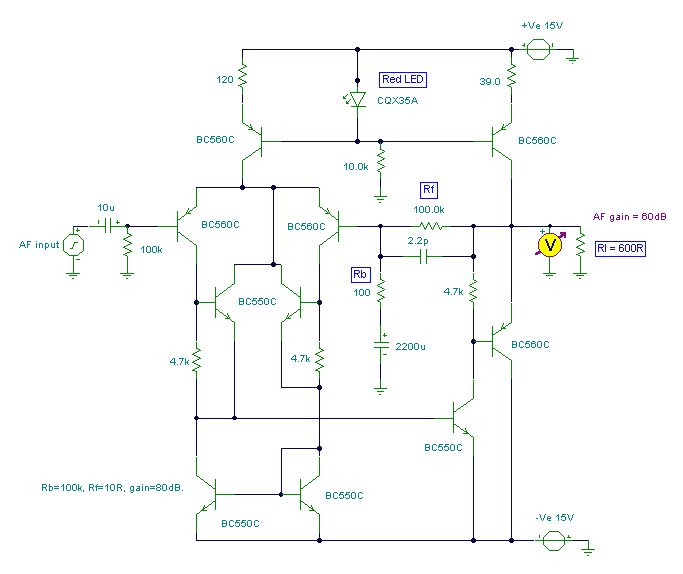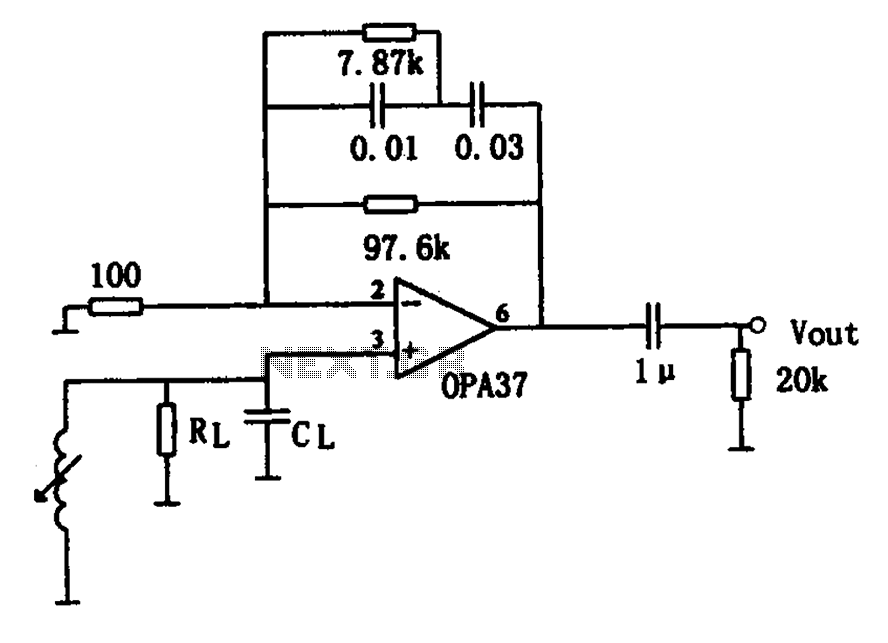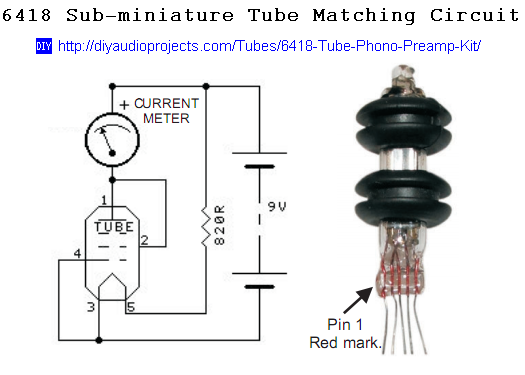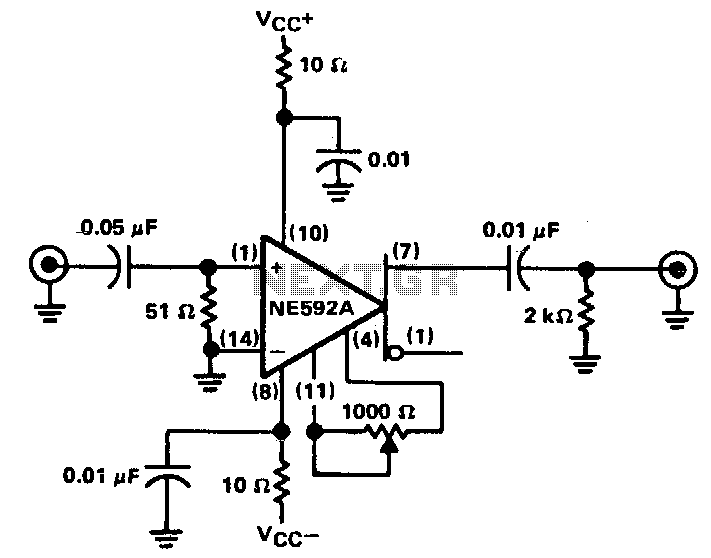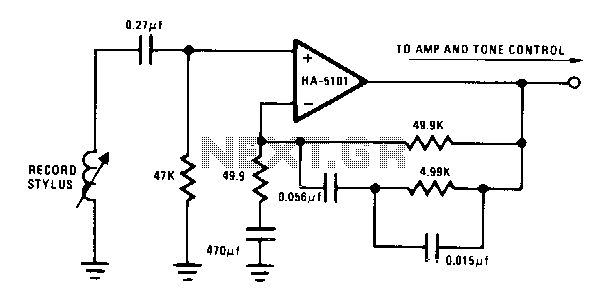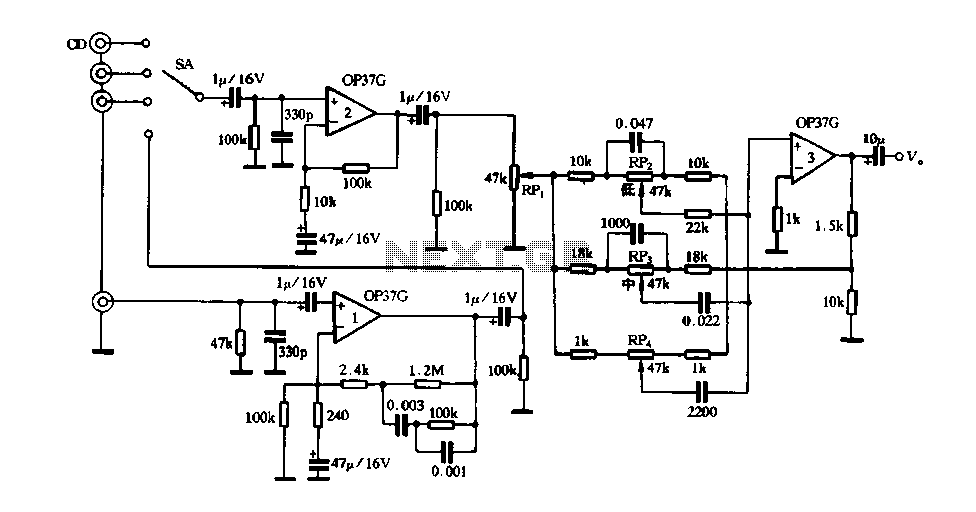
preamp
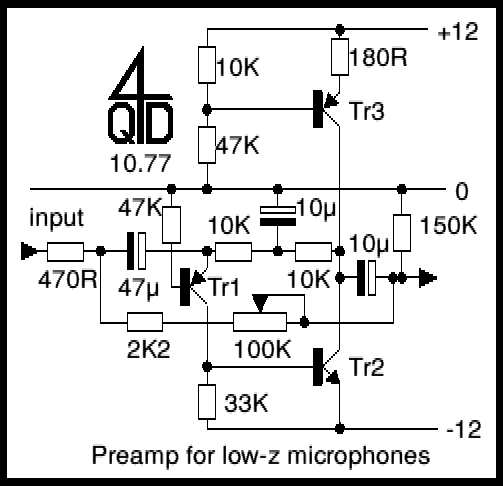
The circuit is straightforward, yet it delivers impressive results. Tr1 operates in grounded base mode, providing a low impedance input through its emitter. The specified values ensure proper operation from a 9V power supply. When using different voltage levels, it may be necessary to adjust the 1.8K resistor to achieve symmetrical clipping at higher levels. For switching the speaker to function both as a speaker and a microphone, it is essential to configure the switch to short the speaker before disconnection. This is crucial because the direct current flowing through Tr1 also passes through the speaker, and disconnecting the speaker can disrupt the DC conditions, resulting in a loud thump. An alternative approach involves placing a 1K resistor in the emitter and using a 100 µF capacitor for speaker coupling. High-quality microphones typically exhibit low impedance, around 600 ohms. This circuit serves as a low input impedance, high-quality preamplifier suitable for applications such as stage mixing desks. Although designed for this purpose, it was not utilized as the designer left the company shortly thereafter. The circuit employs a dual rail power supply, which is advantageous due to the presence of multiple op-amps in the system. It is important to note that Tr1 is a PNP transistor, which theoretically can produce lower noise levels compared to NPN transistors. Tr2 amplifies the output from Tr1, while Tr3 acts as a constant current collector load for Tr2, with its current regulated by the 180 ohm emitter resistor. This value can be adjusted to provide more current for lower impedance output loads. Overall negative feedback is implemented through a 100K logarithmic potentiometer, serving as the gain control. The feedback loop incorporates both input and output capacitors, ensuring excellent low-frequency response. A 150K resistor is included to charge the input and output capacitors, preventing thumps when connecting or disconnecting a microphone. The voltage across these capacitors is minimal, approximately 0.5 volts. It is also possible to achieve similar functionality using an op-amp; however, transistors offer the advantage of easy replacement in case of noise issues, while sourcing low-noise op-amps may be more challenging. The third circuit under consideration was under development when the designer departed from the audio company, but it shows potential for versatility. It can function as a low impedance microphone amplifier or as a high input impedance preamplifier for microphones, or, with appropriate RIAA equalization, for phono pickups or similar devices. Additionally, it may be utilized as a balanced input microphone preamplifier. This design is related to the four-transistor op-amp circuit showcased on the index page, which forms the core of a low distortion power amplifier. R1 determines the impedance of the high impedance input, typically set at 100K. R4 is responsible for charging the output capacitor. R3 regulates the operating current in Tr4, generally set at 1K for approximately 500 µA. The feedback paths are distinct: DC feedback occurs through two 100K resistors, which are decoupled to avoid interference with AC feedback. AC feedback is routed through the network Zf, which can be configured for RIAA equalization for phono applications or adjusted as needed. Ultrasonic applications, including circuits for sound amplification from microphones for ultrasonic detection and remote control, can also be adapted for audio use.The circuit is so simple that there is little to say about it, but it gives very good results. Tr1 is operated in grounded base mode with input to its emitter to give low impedance input. The values shown give correct operation from 9v. If operating from other voltages you may wish to alter the 1K8 resistor to give symmetrical clipping at high lev els. If you wish to switch the speaker (to use the same speaker as a speaker and as a mic, then you should arrange the switching to short the speaker out before disconnecting it. This is because the d. c. through Tr1 also flows through the speaker so removing the speaker will upset the d. c. conditions and cause a large thump in the speaker. You could of course fit a 1K resistor in the emitter and use a 100 µF capacitor to couple the speaker.
High quality microphones also tend to be low impedance, typically around 600 ohms. This is a low input impedance, high quality pre-amplifier of the sort that could be used in a stage mixing desk. In fact that was the purpose for which it was designed, but never used because I soon after left the company.
The circuit uses a dual rail power supply - convenient because there were many op-amps in the machine. Note that Tr1 is a PNP transistor. Theoretically PNP transistors can have lower noise level than NPNs. Tr2 amplifies Tr1`s output. Tr3 is simply a constant current collector load for Tr2, with its current controlled by the 180R emitter resistor.
This can be altered to give more current to feed lower impedance output loads. Overall negative feedback is applied via the 100K pot (log is best) which is the gain control. Note that the feedback loop includes the input and output capacitors so the low frequency response is excellent. The 150K resistor is present to charge up the input and output capacitors to avoid thumps when inserting/withdrawing a microphone.
The voltage across these two capacitors is very small in any case (about 1/2 volt). You can of course do this with an op-amp. One advantage of transistors is that you can easily change a noisy one. Selecting a low noise op-amp may not be so easy. Also of course most constructors will have suitable transistors. You may not have a suitable low noise op-amp to hand! The third circuit is one I was working on as I left the audio company but is seems to be potentially very useful. It should be simple to use it as a low impedance mic amp or as a high input impedance preamp for mic or, with a suitable RIAA equalization, for phono pickup or similar.
It can even be used as a balanced input mic preamp. If you have been browsing this site you may notice that it is the 4 transistor op-amp circuit shown on the index page and at the heart of the low distortion power amplifier. R1 will define the impedance if the high impedance input - say 100K. R4 charges the output capacitor only. R3 defines the operating current in Tr4, say 1K for 500 µA or so. The feedback paths have been separated: d. c. feedback is via the two 100K resistors, which are decoupled so they don`t affect the a. c. feedback. A. c. feedback if via the network Zf, which can be RIAA for phono or whatever as required. Ultrasonics - a page on intruded detectors and remote control has circuits used to amplify sound from microphones for ultrasonics.
These can be adapted for audio use. 🔗 External reference
High quality microphones also tend to be low impedance, typically around 600 ohms. This is a low input impedance, high quality pre-amplifier of the sort that could be used in a stage mixing desk. In fact that was the purpose for which it was designed, but never used because I soon after left the company.
The circuit uses a dual rail power supply - convenient because there were many op-amps in the machine. Note that Tr1 is a PNP transistor. Theoretically PNP transistors can have lower noise level than NPNs. Tr2 amplifies Tr1`s output. Tr3 is simply a constant current collector load for Tr2, with its current controlled by the 180R emitter resistor.
This can be altered to give more current to feed lower impedance output loads. Overall negative feedback is applied via the 100K pot (log is best) which is the gain control. Note that the feedback loop includes the input and output capacitors so the low frequency response is excellent. The 150K resistor is present to charge up the input and output capacitors to avoid thumps when inserting/withdrawing a microphone.
The voltage across these two capacitors is very small in any case (about 1/2 volt). You can of course do this with an op-amp. One advantage of transistors is that you can easily change a noisy one. Selecting a low noise op-amp may not be so easy. Also of course most constructors will have suitable transistors. You may not have a suitable low noise op-amp to hand! The third circuit is one I was working on as I left the audio company but is seems to be potentially very useful. It should be simple to use it as a low impedance mic amp or as a high input impedance preamp for mic or, with a suitable RIAA equalization, for phono pickup or similar.
It can even be used as a balanced input mic preamp. If you have been browsing this site you may notice that it is the 4 transistor op-amp circuit shown on the index page and at the heart of the low distortion power amplifier. R1 will define the impedance if the high impedance input - say 100K. R4 charges the output capacitor only. R3 defines the operating current in Tr4, say 1K for 500 µA or so. The feedback paths have been separated: d. c. feedback is via the two 100K resistors, which are decoupled so they don`t affect the a. c. feedback. A. c. feedback if via the network Zf, which can be RIAA for phono or whatever as required. Ultrasonics - a page on intruded detectors and remote control has circuits used to amplify sound from microphones for ultrasonics.
These can be adapted for audio use. 🔗 External reference
